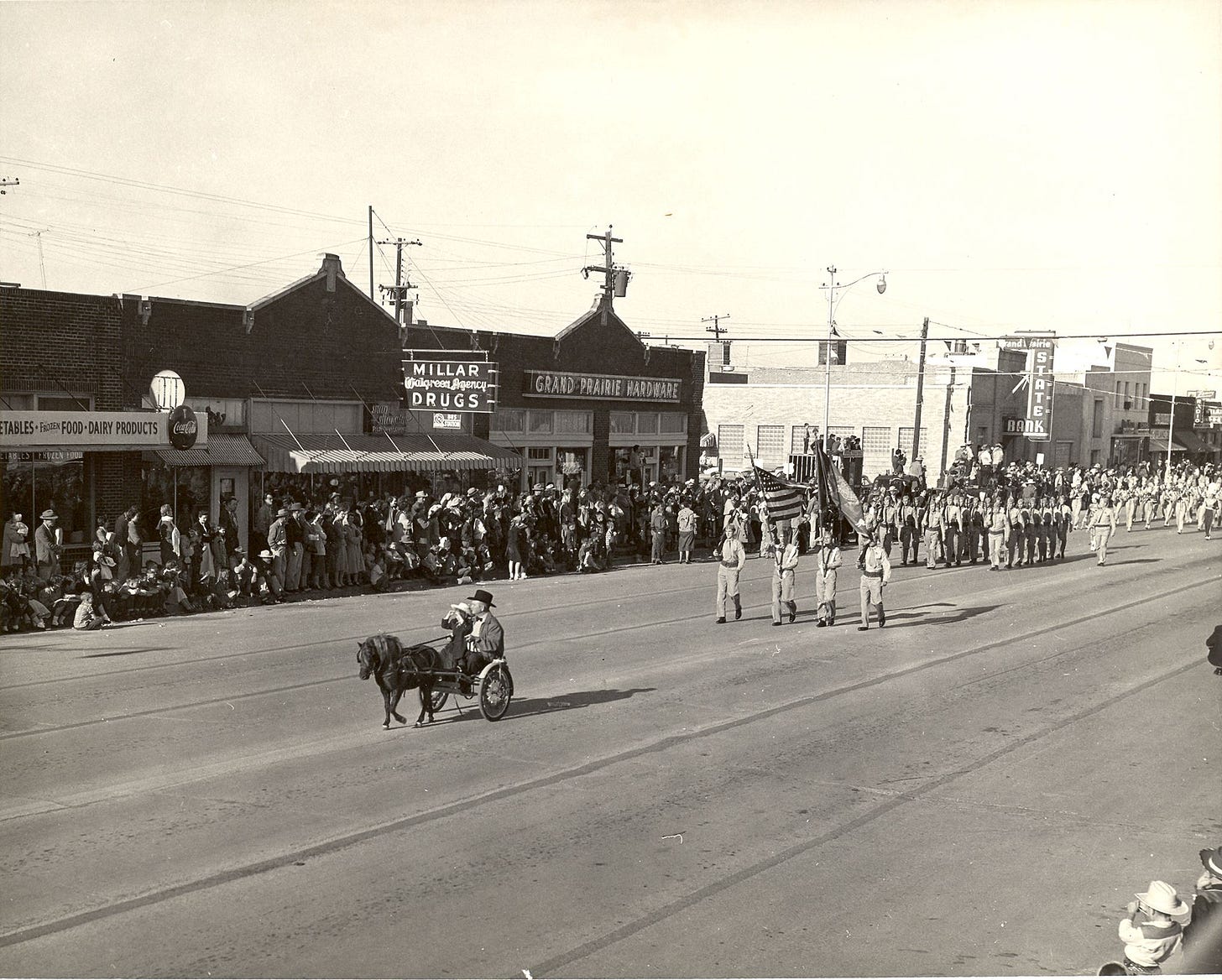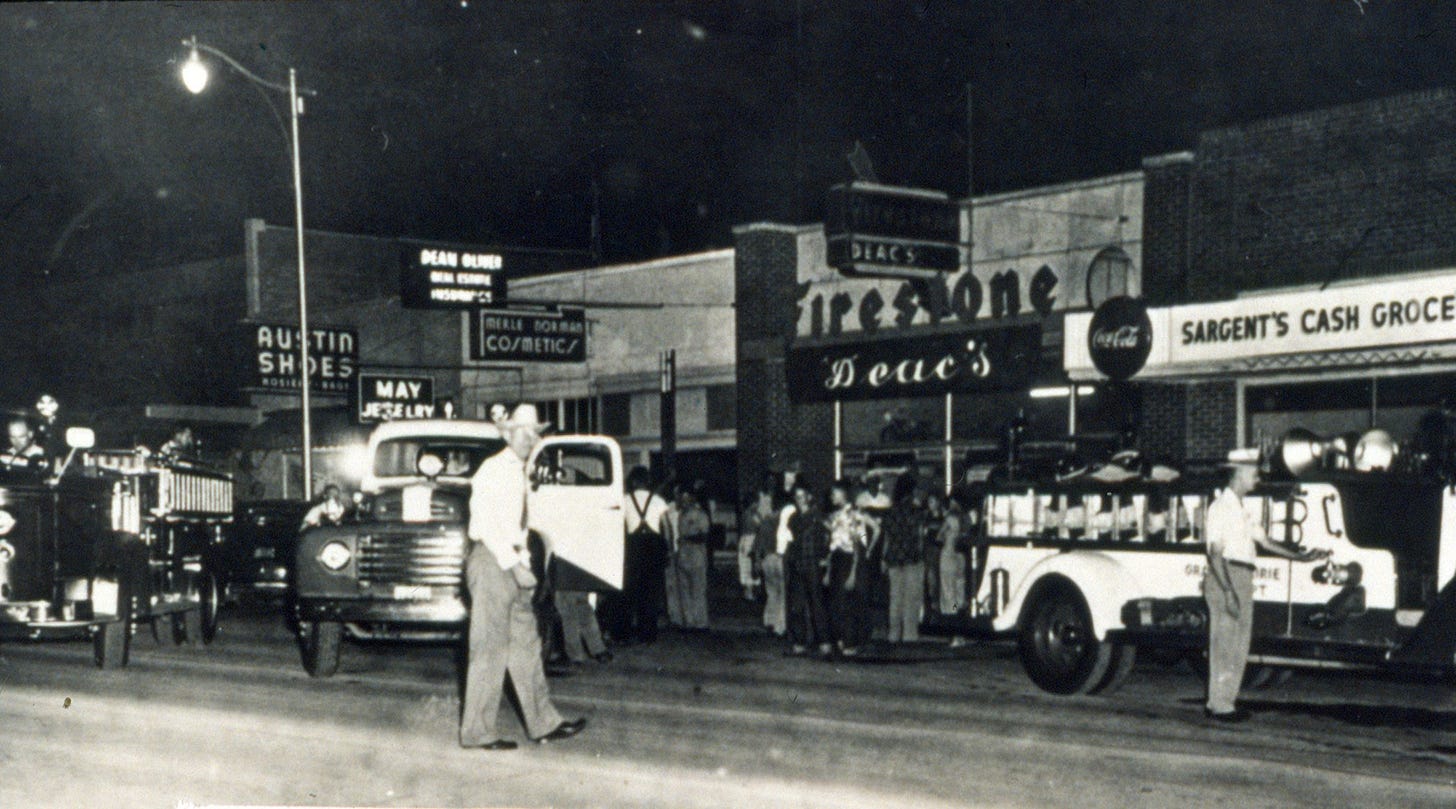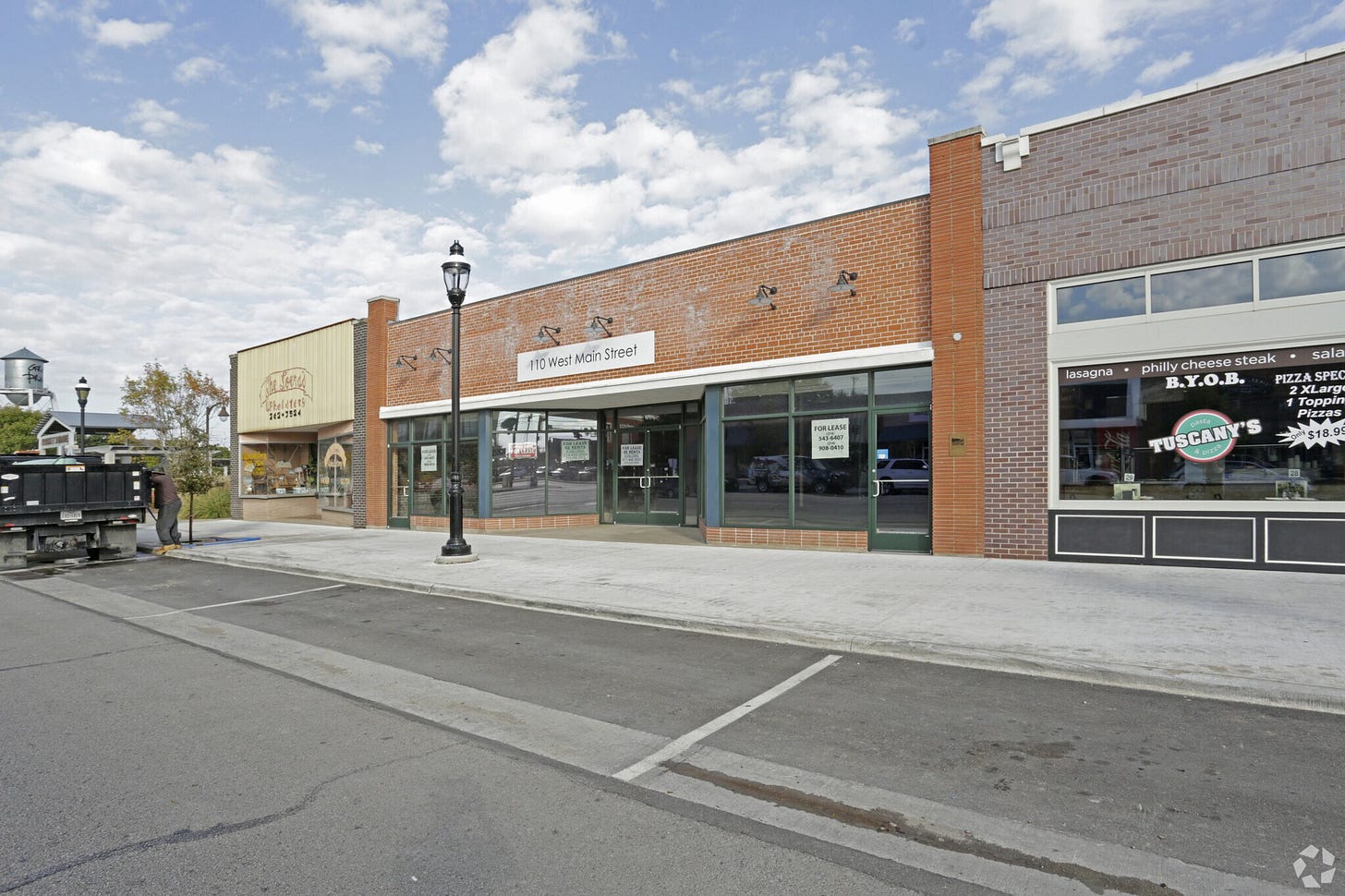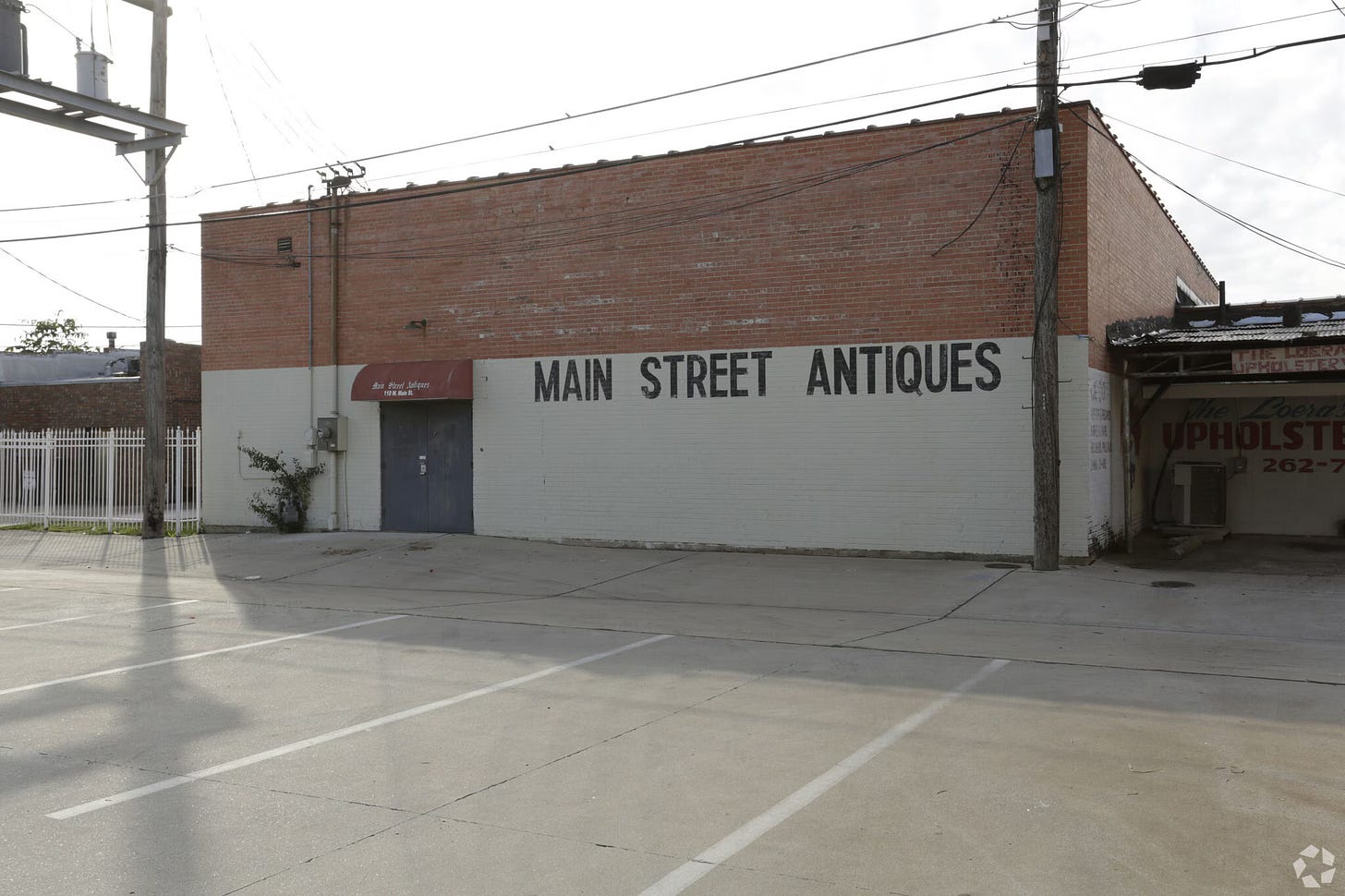Main Street’s Longest-Running Empty Listing - 110 W. Main Street
A look at one high-profile Main Street property that’s stayed vacant for over a decade, despite steady interest.
This story is part of the Faces of Grand Prairie Real Estate Channel, where we cover local properties, market trends, and the people shaping Grand Prairie’s future. If you’d like to support this kind of community reporting, email us at facesofgrandprairie@gmail.com.
Since 2012, 110 Main Street in Grand Prairie has sat silent. The last time its doors were open, it was home to Main Street Antiques — a beloved local shop where neighbors browsed vintage treasures and got clocks repaired. Today, it’s the only storefront on Main that has been vacant for over a decade. The brick façade, though faded, still has beautiful bones — but the building is in need of maintenance, such as a new roof and other major repairs. There’s no pictures of the inside of the property and the pictures from the outside are not recent.
This space has a long and varied history. In the 1950s, it was Sargent’s Cash Grocery. Later, it became CR Anthony Co., a clothing store that remained until 1969, when it transformed into the Piano and Organ Broker’s Headquarters for several years. Each chapter left its mark, adding to the building’s legacy as a Main Street fixture.


The property is currently owned by Jim Lake Jr. and Amanda Moreno-Lake, a couple known for purchasing iconic spaces in historic downtown districts. They’ve received positive press from outlets like D Magazine for their work in areas like Bishop Arts and Waxahachie, with real estate features highlighting their role in revitalizing downtown corridors. However, their approach hasn’t been without controversy — in Waxahachie, for example, they allowed the iconic Texas Theater to sit empty for years without any visible progress, drawing frustration from some community members.
Here in Grand Prairie, 110 Main Street has been “For Lease” — either online or by sign — for all 13 years. I called on it myself just yesterday, and the listing agent told me the asking rent is $7,000 a month.
Over the years, there’s been no shortage of interest. According to Grand Prairie real estate agents, community members, and even current and former city council members, multiple tenants have tried to make it work — some concept ideas have been a consignment store with a soda fountain (my own attempt nine years ago), a sports grill, an art gallery, even the Grand Prairie Chamber of Commerce, and most recently, a restaurant that nearly signed a deal. None stuck. I personally toured the space nine years ago when it was listed with different agents, and couldn’t get them to negotiate price even a dime.
The problem isn’t interest — it’s price, and, in the eyes of some in the community, an apparent lack of interest from the owner in actually leasing the space. Historically, the rent has ranged anywhere from $5,000 up to a rumored $12,000 a month, numbers that don’t match the foot traffic reality of Main Street, which is more of a throughway than a pedestrian-heavy square. In commercial real estate, rents are tied to comparables and to a location’s ability to produce income. If a business can’t reasonably expect enough customers to cover rent and still turn a profit, no deal gets signed — no matter how charming the space.
With Main Street now undergoing intense renovation — including the demolition of several historic buildings, to the sadness of many — the Lakes have evidently tried to be part of that transformation. The rumor in town is that they may be holding onto 110 Main Street to “wait for something else to come along” after the renovation is complete.
City streets should not be treated simply as a tick mark on a financial portfolio, but unfortunately that has become the nature of the real estate beast.
And this isn’t just a downtown issue. It’s estimated that 40% of homes in Grand Prairie are investment properties, with 20% owned by people who don’t live in Grand Prairie at all. That means a significant portion of our neighborhoods — not just our Main Streets — are controlled by owners who may have no day-to-day connection to the life of this community.
As a Realtor and a firm believer in the Texas approach to property ownership, I’ll always defend an owner’s right to do what they wish with their property. But that right does not make anyone immune to community feedback or conversation. The majority of investors, in my view, do genuinely want to be part of their community — not simply own a piece of it for personal gain.
Legally, a property owner can set whatever rent they like and wait for someone to meet it. But morally, when a building sits empty for over a decade — contributing nothing to the vibrancy of the street, slowly falling into disrepair, and becoming a visual reminder of stagnation — is there an obligation to the community to find a solution?
And it would be one thing if they simply let the building sit empty without advertising it. But that’s not the case — it’s been actively listed “For Lease” for 13 years, both online and with signage. That’s the real sticking point for many: why market a property so visibly if you don’t truly want to lease it? Let it sit empty if you must, but advertising it while every deal falls through creates an entirely different set of questions.
And there’s another uncomfortable question: when potential tenants are willing to meet the asking price and deals still don’t happen, is the owner truly interested in leasing the property — or just maintaining the appearance of wanting to? A “For Lease” sign signals opportunity, but if every negotiation ends in a dead end, people start to wonder if the sign is more prop than promise. As one commenter who had attempted to do a deal there put it on my Facebook post inquiry, “They are not interested in leasing. Just pretending.”
There’s a difference between owning property as a steward — someone who sees themselves as part of the fabric of a place — and owning it purely as an asset to be maximized, regardless of time or impact.
Stewardship might mean:
Setting a rent that allows a small business to get a foothold.
Offering a short-term reduced lease to get activity going.
Partnering with the city or a nonprofit for temporary programming until a long-term tenant is found.
Speculation, on the other hand, can mean holding out for a rent number that may never be realistic — while the building, and the block around it, pays the price.
The case of 110 Main Street isn’t unique — every city has a “that building” people drive by and shake their heads about. But it raises a bigger question: When you own a piece of a community, is your responsibility only to your bottom line, or also to the life of the street outside your door?
Because in the long run, a healthy community isn’t just good for its residents — it’s good for business, too.




